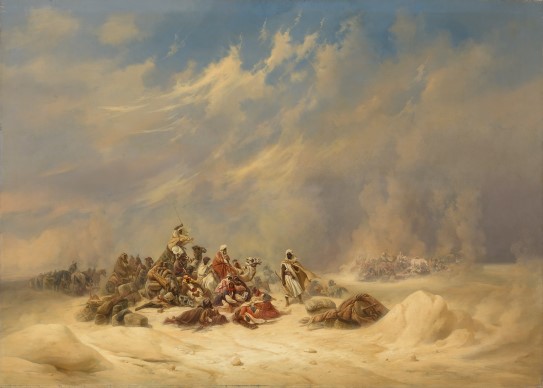A Caravan in Sandstorm
Niels Simonsen
Transcription
Stina Högkvist:
This isn’t a snapshot of something that actually happened, it’s a kind of illusion. And so we have a fantasy that’s being communicated to the viewer.
Narrator:
Stina Högkvist, the National Museum’s Director of Exhibitions and Collections, is talking about “A Caravan overtaken by a Storm in the Desert”, painted by the Danish artist Niels Simonsen in 1855.
In the mid-19th century, European colonialism was in full swing in Africa and the Middle East, which at that time was known as The Orient. More recently, the colonizers have been strongly criticized for their demeaning treatment of Middle Eastern peoples as lesser “others”, by portraying them in a manner that became known as Orientalism.
Stina:
Orientalism isn’t really a term that we use today. Today we would tend to talk instead about post-colonialism: who is portraying whom, and who has a voice and who doesn’t have a voice. And that’s why it’s so important to discuss this in today’s light, how paintings and photographs perhaps haven’t always been as innocent as we thought, but have perhaps been part of something bigger, something that today we might refer to as lobbying, for the purposes of promoting the colonial project.
Narrator:
Many of the large museums in Western countries were also actively involved in colonialism. As when the Norwegian National Gallery commissioned this painting from the Orientalist painter Simonsen, specifically because it wanted an example of one of his most popular subjects – an African scene. Stina Högkvist sees this picture as a classic example of Orientalism, a portrayal of "others" – of people who are not like us.
Stina Högkvist:
And when you show that something isn’t like us and at the same time you distance yourself from it, then you’re also boosting your feeling of belonging to a nation, it boosts your sense of identity. "We are modern, they are dirty, they are different." And so these pictures become incredibly important for creating this concept of "the other". And it’s typical that all these depictions that we are looking at were painted by Western artists who were responding to their own and other people’s expectations. Real life would of course have been much more varied than what we see in the images from that period.